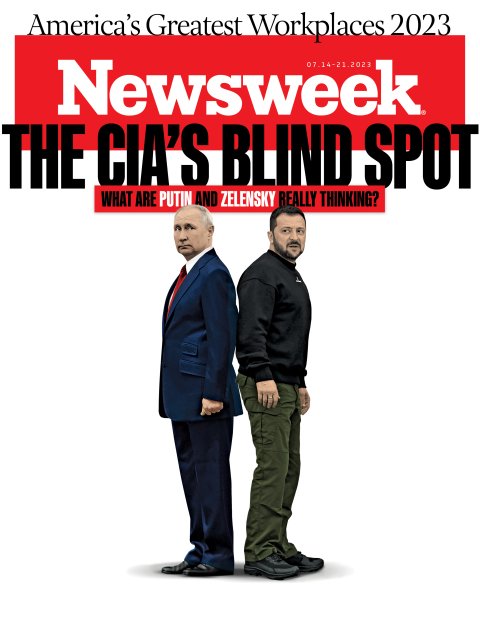One of the biggest secrets of the Ukraine war is how much the CIA doesn't know. The Agency is as uncertain about Volodymyr Zelensky's thinking and intentions as it is about Vladimir Putin's. And as the Russian leader faces his biggest challenge in the aftermath of a failed mutiny, the Agency is straining to understand what the two sides will do—because President Joe Biden has determined that the United States (and Kyiv) will not undertake any actions that might threaten Russia itself or the survival of the Russian state, lest Putin escalate the conflict and engulf all of Europe in a new World War. In exchange, it expects that the Kremlin won't escalate the war beyond Ukraine or resort to the use of nuclear weapons.
America's stance is under threat because the near-mutiny by Yevgeny Prigozhin, head of the Wagner Group, raises the question as to whether Moscow has run out of options.
"Putin's back is really against the wall" a senior defense intelligence official tells Newsweek, warning that while the CIA fully grasps how much Russia is stuck in Ukraine, it is very much in the dark with regard to what Putin might do about it. With talk of Russian nuclear weapons possibly being deployed to Belarus, and in light of Prigozhin's public exposure of the terrible costs of fighting, something that Moscow has suppressed, the official says that it is a particularly delicate moment. "What is happening off the battlefield is now most important," says the official, who was granted anonymity in order to speak candidly. "Both sides pledge to limit their actions, but it falls to the United States to enforce those pledges. This all hinges on the quality of our intelligence."
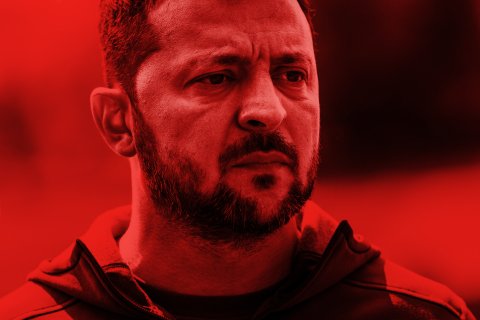
"There is a clandestine war, with clandestine rules, underlying all of what is going on in Ukraine," says a Biden administration senior intelligence official who also spoke with Newsweek. The official, who is directly involved in Ukraine policy planning, requested anonymity to discuss highly classified matters. The official (and numerous other national security officials who spoke to Newsweek) say that Washington and Moscow have decades of experience crafting these clandestine rules, necessitating that the CIA play an outsize role: as primary spy, as negotiator, as supplier of intelligence, as logistician, as wrangler of a network of sensitive NATO relations and perhaps most important of all, as the agency trying to ensure the war does not further spin out of control.
"Don't underestimate the Biden administration's priority to keep Americans out of harm's way and reassure Russia that it doesn't need to escalate," the senior intelligence officer says. "Is the CIA on the ground inside Ukraine?" he asks rhetorically. "Yes, but it's also not nefarious."

Newsweek has examined in depth the scale and scope of the CIA's activities in Ukraine, especially in light of growing Congressional questions about the extent of U.S. aid and whether President Biden is keeping his pledge not to have "boots on the ground." Neither the CIA nor the White House would give specific responses for confirmation, but they asked that Newsweek not reveal the specific locations of CIA operations inside Ukraine or Poland, that it not name other countries involved in the clandestine CIA efforts and that it not name the air service that is supporting the clandestine U.S. logistics effort. After repeated requests for an on-the-record comment, the CIA declined. Neither the Ukrainian nor Russian governments responded to requests for comment.
Over the course of its three-month investigation, Newsweek spoke to over a dozen intelligence experts and officials. Newsweek also sought out contrary views. All of the credible experts and officials Newsweek spoke to agreed that the CIA has been successful in discreetly playing its part in dealing with Kyiv and Moscow, in moving mountains of information and materiel and in dealing with a diverse set of other countries, some of whom are quietly helping while also trying to stay out of Russia's crosshairs. And they didn't dispute that on the CIA's main task—knowing what's going on in the minds of the leaders of Russia and Ukraine—the Agency has had to struggle.

Intelligence experts say this war is unique in that the United States is aligned with Ukraine, yet the two countries are not allies. And though the United States is helping Ukraine against Russia, it is not formally at war with that country. Thus, much of what Washington does to aid Ukraine is kept secret–and much of what is normally in the realm of the U.S. military is being carried out by the Agency. Everything that is done, including work inside Ukraine itself, must comply with limits established by Biden.
"It's a tricky balancing act—the CIA being very active in the war while not contradicting the Biden administration's central pledge, which is that there are no American boots on the ground," says a second senior intelligence official who was granted anonymity to speak with Newsweek.
For the CIA, its major role in the war in Ukraine has provided a boost in morale after the sour relationship between former President Donald Trump and his spy chiefs. The second official says that while some in the Agency want to speak more openly about its renewed significance, that is not likely to happen. "The corporate CIA worries that too much bravado about its role could provoke Putin," the intelligence official says.

That is partly why the CIA is also keen to distance itself from anything that suggests a direct attack on Russia and any role in actual combat—something Kyiv has repeatedly done, from the sabotage of the Nord Stream pipeline and the Kerch Strait bridge to drone and special operations attacks across the border. These attacks seem contrary to pledges by Zelensky that Ukraine would not take actions that might expand the scope of the war.
"The view advanced by many that the CIA is central to the fighting—say, for instance, in killing Russian generals on the battlefield or in important strikes outside Ukraine, such as the sinking of the Moskva flagship–doesn't play well in Kyiv," says one retired senior military intelligence official granted anonymity to speak with Newsweek. "If we want Kyiv to listen to us, we need to remind ourselves that the Ukrainians are winning the war, not us."
Washington has quietly expressed its displeasure to the Zelensky government with regard to the Nord Stream attack last September, but that act of sabotage was followed by other strikes, including the recent drone attack on the Kremlin itself. Those have raised questions over one of the CIA's main intelligence responsibilities—knowing enough of what the Ukrainians are planning to both influence them and to adhere to their secret agreement with Moscow.
Trouble Shooting
The CIA was central to the war even before it started. At the beginning of his administration, Biden tapped director William Burns as his global trouble shooter—a clandestine operator able to communicate with foreign leaders outside normal channels, someone who could occupy important geopolitical space between overt and covert, and an official who could organize work in the arena that exists between what is strictly military and what is strictly civilian.
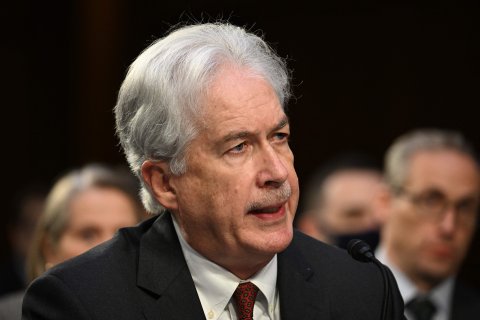
As former Ambassador to Russia, Burns has been particularly influential with regard to Ukraine. The CIA had been monitoring Russia's buildup and in November 2021, three months before the invasion, Biden dispatched Burns to Moscow to warn the Kremlin of the consequences of any attack. Though the Russian president snubbed Biden's emissary by staying at his retreat in Sochi on the Black Sea, 800 miles away, he did agree to speak with Burns via a Kremlin secure phone.
"In some ironic ways though, the meeting was highly successful," says the second senior intelligence official, who was briefed on it. Even though Russia invaded, the two countries were able to accept tried and true rules of the road. The United States would not fight directly nor seek regime change, the Biden administration pledged. Russia would limit its assault to Ukraine and act in accordance with unstated but well-understood guidelines for secret operations.
"There are clandestine rules of the road," says the senior defense intelligence official, "even if they are not codified on paper, particularly when one isn't engaged in a war of annihilation." This includes staying within day-to-day boundaries of spying, not crossing certain borders and not attacking each other's leadership or diplomats. "Generally the Russians have respected these global red lines, even if those lines are invisible," the official says.
Once Russian forces poured into Ukraine, the United States had to quickly shift gears. The CIA, like the rest of the U.S. intelligence community, had misread Russia's military capacity and Ukraine's resilience as Russia failed to take Kyiv and withdrew from the north.
By last July, both sides settled in for a long war. As the war shifted, Washington's focus changed from very public and symbolic troop deployments to Europe to "deter" further Russian moves, to providing weapons to sustain Ukraine's ability to fight. In the face of Zelensky's masterful public lobbying, the United States slowly and reluctantly agreed to supply better and longer-range weapons, weapons that in theory could threaten Russian territory and thus flirt with the feared escalation.
"Zelensky has certainly outdone everyone else in getting what he wants, but Kyiv has had to agree to obey certain invisible lines as well," says the senior defense intelligence official. In secret diplomacy largely led by the CIA, Kyiv pledged not to use the weapons to attack Russia itself. Zelensky has said openly that Ukraine will not attack Russia.
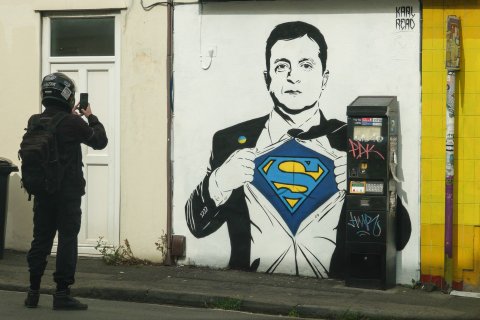
Behind the scenes, dozens of countries also had to be persuaded to accept the Biden administration's limits. Some of these countries, including Britain and Poland, are willing to take more risk than the White House is comfortable with. Others—including some of Ukraine's neighbors—do not entirely share American and Ukrainian zeal for the conflict, do not enjoy unanimous public support in their anti-Russian efforts and do not want to antagonize Putin.
It fell to the CIA to manage this underworld, working through its foreign intelligence counterparts and secret police rather than public politicians and diplomats. The Agency established its own operating bases and staging areas. The CIA sought help from Ukraine's neighbors in better understanding Putin as well as Zelensky and his administration. Agency personnel went into and out of Ukraine on secret missions, to assist with the operations of new weapons and systems, some of which were not publicly divulged. But the CIA operations were always conducted with an eye to avoid direct confrontation with Russian troops.
"The CIA has been operating inside Ukraine, under strict rules, and with a cap on how many personnel can be in country at any one time," says another senior military intelligence official. "Black special operators are restricted from conducting clandestine missions, and when they do, it is within a very narrow scope." (Black special operations refers to those that are conducted clandestinely.)
Simply, CIA personnel can routinely go—and can do—what U.S. military personnel can't. That includes inside Ukraine. The military, on the other hand, is restricted from entering Ukraine, except under strict guidelines that have to be approved by the White House. This limits the Pentagon to a small number of Embassy personnel in Kyiv. Newsweek was unable to establish the exact number of CIA personnel in Ukraine, but sources suggest it is less than 100 at any one time.
After all the members of the U.S. military were publicly withdrawn from Ukraine in February 2022 including special operations forces that had been behind the scenes, the White House established the roles that different agencies could play in the U.S. response. President Biden signed national security directives and a "presidential finding" authorizing certain covert operations against Russia. "Lanes of the road" were established between the Pentagon and the CIA, just as they had been established in Afghanistan immediately after 9/11. Burns and Secretary of Defense Lloyd Austin work closely together; the relations of the two agencies, according to the CIA, have never been better.
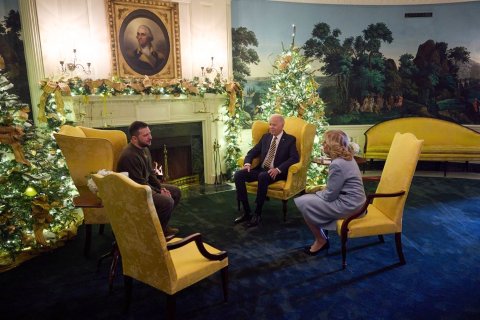
Now, more than a year after the invasion, the United States sustains two massive networks, one public and the other clandestine. Ships deliver goods to ports in Belgium, the Netherlands, Germany and Poland, and those supplies are moved by truck, train and air to Ukraine. Clandestinely though, a fleet of commercial aircraft (the "grey fleet") crisscrosses Central and Eastern Europe, moving arms and supporting CIA operations. The CIA asked Newsweek not to identify specific bases where this network is operating, nor to name the contractor operating the planes. The senior administration official said much of the network had been successfully kept under wraps, and that it was wrong to assume that Russian intelligence knows the details of the CIA's efforts. Washington believes that If the supply route were known, Russia would attack the hubs and routes, the official said.
None of this can be sustained without a major counter-intelligence effort to thwart Russia's own spying, the bread-and-butter work of the Agency. Russian intelligence is very active in Ukraine, intelligence experts say, and almost anything the U.S. shares with Ukraine is assumed to also make it to Russian intelligence. Other Eastern European countries are equally riddled with Russian spies and sympathizers, particularly the frontline countries.
"A good part of our time is taken up hunting down Russian penetrations of foreign governments and intelligence services," says a military counterintelligence official working on the Ukraine war. "We have been successful in identifying Russian spies inside the Ukrainian government and military, and at various other points in the supply chain. But Russian penetration of Eastern European countries, even those who are members of NATO, is deep, and Russian influence operations are of direct concern."
As billions of dollars worth of arms started flowing through Eastern Europe, another issue that the CIA is working on is the task of fighting corruption, which turned out to be a major problem. This involves not only accounting for where weapons are going but also quashing the pilfering and kickbacks involved in the movement of so much materiel to Ukraine.
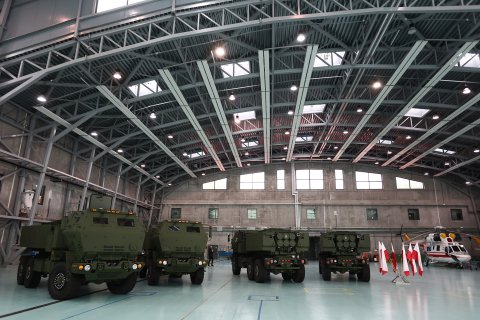
The Poland Connection
Less than a month after Russian tanks crossed the border on their way to Kyiv, CIA Director Burns landed in Warsaw, visiting with the directors of Poland's intelligence agencies and putting together the final agreements that would allow the CIA to use Ukraine's neighbor as its clandestine hub.
Since the end of the Cold War, Poland and the United States, through the CIA, have established particularly warm relations. Poland hosted a CIA torture "black site" in the village of Stare Kiejkuty during 2002-2003. And after the initial Russian invasion of Donbas and Crimea in 2014, CIA activity expanded to make Poland its third-largest station in Europe.
Poland officially became the center of NATO's response, first in handling hundreds of thousands of refugees fleeing the battle, and then as the logistical hub for arms flowing back into Ukraine. The country also became the center of the overt military response. A forward headquarters for the Army V Corps (5th Corps) has been established in Poland. Additional supplies and ammunition for U.S. use are stored in Poland. A permanent Army garrison has been activated, the first ever to be located on NATO's eastern flank, and today there are now about 10,000 American troops in Poland.
But Poland's real value is its role in the CIA's secret war. Burns returned to Warsaw last April, meeting again with Minister of the Interior and "special services" coordinator Mariusz Kaminski, his Polish counterpart, to discuss the scope of cooperation between the two countries, especially in collecting intelligence. From Poland, CIA case officers are able to connect with their many agents, including Ukrainian and Russian spies. CIA ground branch personnel of the Special Activities Center handle security and interact with their Ukrainian partners and the special operations forces of 20 nations, almost all of whom also operate from Polish bases. CIA cyber operators work closely with their Polish partners.
The closeness of U.S.-Polish relations particularly paid off over 24 hours last November. Burns was at Turkish intelligence headquarters in Ankara meeting with Sergei Naryshkin, his Russian counterpart. There he stressed "strategic stability," according to a senior U.S. government official, and he delivered a new backchannel warning that the United States would not tolerate nuclear threats or escalation. From Turkey he flew on to Ukraine to brief Zelensky on the talks.

While he was in transit, a missile landed in the Polish town of Przewodow, less than 20 miles from the Ukraine border, setting off a diplomatic and press frenzy. A Russian attack on a NATO country would trigger Article 5 of the NATO charter, the principle that an attack on one was an attack on all. But U.S. intelligence, through monitoring thermal signatures that track every missile launch, immediately knew the missile originated from inside Ukraine and not from Russia. (It turned out to be a Ukrainian surface-to-air missile that had gone awry.) Burns got the intelligence from Washington and immediately transmitted it to Polish president Andrzej Duda.
One crisis was averted. But a new one was brewing. Strikes inside Russia were continuing and even increasing, contrary to the fundamental U.S. condition for supporting Ukraine. There was a mysterious spate of assassinations and acts of sabotage inside Russia, some occurring in and around Moscow. Some of the attacks, the CIA concluded, were domestic in origin, undertaken by a nascent Russian opposition. But others were the work of Ukraine—even if analysts were unsure of the extent of Zelensky's direction or involvement.
'Karma Is a Cruel Thing'
Early in the war, Kyiv made its own "non-agreement" with Washington to accept the Biden administration's limitations on attacking Russia, even though that put it at a military disadvantage as Russian forces launched air and missile attacks from their own territory. In exchange, the U.S. promised arms and intelligence that came in ever greater quantities and firepower as Zelensky pushed harder.
The "non-agreement held up for quite some time. There were occasional cross-border artillery attacks and some errant weapons that landed in Russia; in each case Ukraine denied any involvement.
Then came the attack on the Nord Stream gas pipelines on September 26. Although not in Russia, they were majority-owned by Russian state gas firm Gazprom. Again, Ukraine denied involvement despite the suspicions of the CIA. We have "nothing to do with the Baltic Sea mishap and have no information about...sabotage groups," Zelensky's top aide said, calling any speculation to the contrary "amusing conspiracy theories."
Next came the truck bomb attack on the Kerch Strait bridge on October 8. Ukraine had threatened to attack the 12-mile bridge that links Russia and the Crimean Peninsula, which Moscow had annexed in 2014 in a move condemned as illegal by much of the world. Though it wasn't clear who carried out the attack, Putin blamed Ukrainian "special services." Meeting with his Security Council, Putin said, "If attempts continue to carry out terrorist acts on our territory, Russia's responses will be harsh and in their scale will correspond to the level of threats created for the Russian Federation." And indeed Russia did respond with multiple attacks on targets in Ukrainian cities.
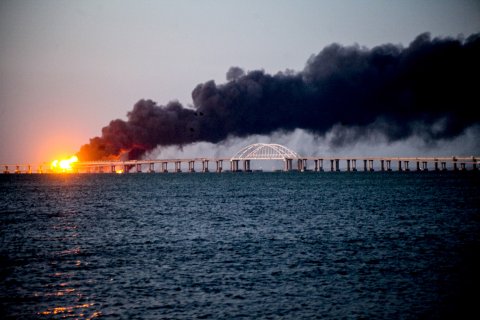
"These attacks only further reinforce our commitment to stand with the people of Ukraine for as long as it takes," the White House said of the Russian retaliatory strike. Behind the scenes, though, the CIA was scrambling to determine the origins.
"The CIA learned with the attack on the Crimea bridge that Zelensky either didn't have complete control over his own military or didn't want to know of certain actions," says the military intelligence official.
The Kerch bridge attack was followed by an even longer-range strike on the Engels Russian bomber base, almost 700 miles from Kyiv. The CIA did not know about any of these attacks beforehand, according to a senior U.S. official, but rumors started to circulate that the Agency was, through some mysterious third party, directing others to strike Russia. The Agency delivered a strong and unusual on-the-record denial. "The allegation that CIA is somehow supporting saboteur networks in Russia is categorically false," CIA spokesperson Tammy Thorp said.
In January this year, Burns was back in Kyiv to meet with Zelensky and his Ukrainian counterparts, discussing the clandestine war and the need to preserve strategic stability. "Kyiv was beginning to taste a potential victory and was therefore more willing to take risks," says the second senior intelligence official. "But Russian sabotage groups also had emerged by the end of the year." The January talks had little impact. As for the sabotage strikes themselves, the senior U.S. government official tells Newsweek that the CIA has had no prior knowledge of any Ukrainian operations.
All of this culminated in the May 3 drone attack inside the Kremlin walls in Moscow. Russia's Security Council Secretary Nikolai Patrushev blamed the United States and Britain, saying that "the terrorist attacks committed in Russia are...designed to destabilize the socio-political situation, and to undermine the constitutional foundations and sovereignty of Russia." Ukrainian officials implicitly admitted culpability. "Karma is a cruel thing," Zelensky advisor Mykhailo Podolyak responded, adding fuel to the fire.
A senior Polish government official told Newsweek that it might be impossible to convince Kyiv to abide by the non-agreement it made to keep the war limited. "In my humble opinion, the CIA fails to understand the nature of the Ukrainian state and the reckless factions that exist there," says the Polish official, who requested anonymity in order to speak candidly.
In response, the senior U.S. defense intelligence official stressed the delicate balance the Agency must maintain in its many roles, saying: "I hesitate to say that the CIA has failed." But the official said sabotage attacks and cross border fighting created a whole new complication and continuing Ukrainian sabotage "could have disastrous consequences."
